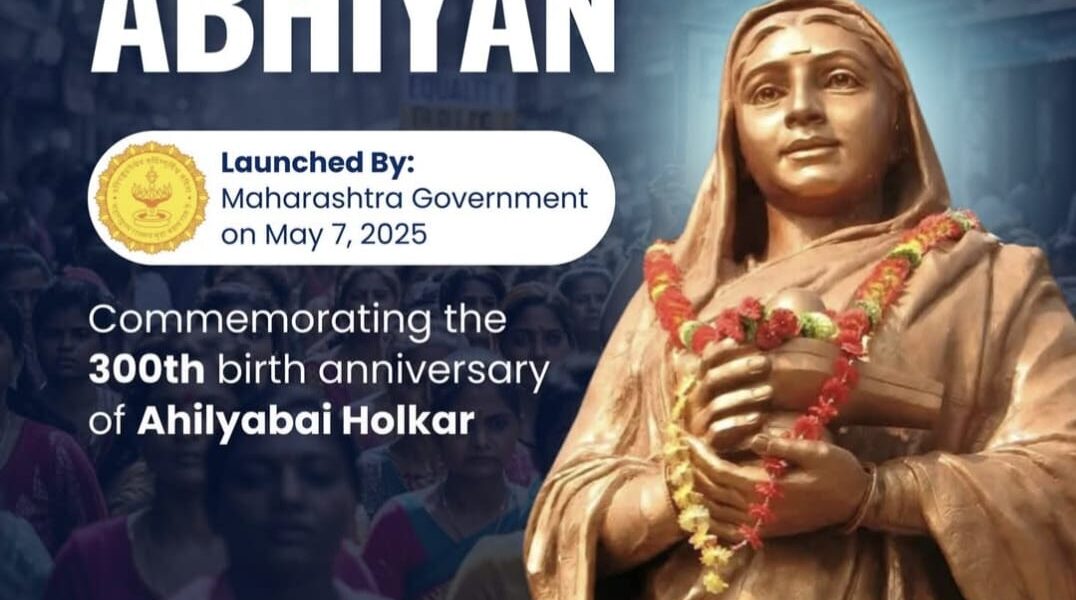Adishakti Abhiyan launched by Maharashtra government on may 7th 2025. Commemorating the 300th birth anniversary of Ahilyabai Holkar.
In a powerful move that intertwines history with social justice, the Maharashtra government unveiled the Adishakti Abhiyan on 7th May 2025, an initiative that aims to uplift women from the grassroots level. Launched to honour the 300th birth anniversary of Ahilyabai Holkar, this mission focuses on some of the most pressing issues affecting women and children across the state.
The Legacy of Ahilyabai Holkar
Ahilyabai Holkar, the revered queen of the Malwa kingdom, was not only a visionary ruler but also a staunch supporter of public welfare, infrastructure, and social reform. Her leadership was marked by empathy, inclusivity, and an unwavering commitment to justice. In many ways, Adishakti Abhiyan mirrors her values, bringing them into the 21st-century context to tackle modern-day challenges.
What Is Adishakti Abhiyan?
Adishakti Abhiyan is a comprehensive state-run initiative by the Maharashtra government with a clear and powerful goal—to empower rural women by raising awareness of welfare schemes for women and children, and tackling social evils head-on. With a robust financial backing of ₹10.5 crore, this campaign is set to roll out state-wide, impacting thousands of villages and lakhs of women and children.
The Core Objectives
The initiative targets multiple social issues, aiming to deliver real change at the grassroots level. It isn’t just about ticking boxes—it’s about transforming lives.
Addressing Malnutrition
Malnutrition remains a silent killer in rural India. The Adishakti Abhiyan aims to bridge the nutritional gaps among women and children by:
- Promoting nutrient-rich local diets
- Conducting health camps and nutrition drives
- Collaborating with Anganwadi centres for supplementary nutrition
Fighting Maternal and Infant Mortality
Despite improvements, maternal and infant mortality rates in rural Maharashtra still cause concern. This initiative puts special emphasis on:
- Regular health check-ups and immunisations
- Strengthening prenatal and postnatal care
- Ensuring availability of trained midwives and ASHA workers
Preventing Domestic Violence
Domestic violence is often brushed under the rug in patriarchal setups. Adishakti Abhiyan introduces:
- Awareness sessions about women’s rights and legal options
- Confidential helplines and community-based reporting tools
- Strong linkage with local police and women protection cells
Combating Child Marriages
Child marriage derails the future of young girls. Through this campaign, the government:
- Conducts village-level education sessions
- Engages with school teachers, Sarpanches, and NGOs
- Sets up vigilance committees to track and report such cases
Promoting Women’s Role in Panchayati Raj
Empowering women politically is key. The initiative fosters female leadership by:
- Encouraging women to run for panchayat seats
- Organising leadership workshops
- Building support networks among elected women representatives
Institutional Framework
To ensure deep penetration and sustainability, committees will be formed at:
- Village level – involving local influencers and frontline workers
- Taluka level – coordination and training hubs
- District level – monitoring and resource allocation
- State level – policy oversight and governance
Also Read: SBI CBO 2025 Notification Out, 2964 Vacancies, Online Form Begins
Adishakti Awards
Recognition plays a huge role in motivation. The government will introduce Adishakti Awards to:
- Honour best-performing Gram Panchayats
- Offer monetary incentives and certificates
- Highlight success stories across media
Budget and Financial Allocation
The ₹10.5 crore budget isn’t just a number—it’s a fuel tank. Here’s how it will be put to use:
- 40% for training and awareness drives
- 20% towards healthcare interventions
- 15% for award incentives
- 10% for monitoring and evaluation
- 15% as contingency and emergency fund
Implementation Strategy
This isn’t a one-and-done plan. It unfolds in three strategic phases:
- Awareness Phase – Mass media campaigns, village sabhas, and school drives
- Action Phase – Rolling out services, distributing materials, and interventions
- Review Phase – Data collection, impact analysis, and course correction
The Impact So Far
Though it’s early days, pilot villages have shown:
- A noticeable increase in female voter registration
- Sharp decline in early marriage reports
- Boost in participation of women in gram sabhas
Challenges Ahead
As with any massive undertaking, obstacles remain:
- Cultural resistance in deeply patriarchal areas
- Ensuring consistent funding and logistics
- Keeping the momentum alive post initial rollout
But with sustained effort and community involvement, these hurdles can be overcome.
Conclusion
The Adishakti Abhiyan is not just a government scheme—it’s a movement. A revolution seeded in the soil of Maharashtra to honour a queen’s legacy and build a future where women aren’t just participants but pioneers. If executed with sincerity and support, this initiative could serve as a blueprint for other Indian states to emulate.
1. Who can benefit from the Adishakti Abhiyan?
Primarily rural women and children across Maharashtra, especially those unaware of their rights and government schemes.
2. How are local communities involved in this programme?
By forming village-level committees and involving local leaders, teachers, ASHA workers, and gram panchayat members.
3. What are the Adishakti Awards?
These are awards given to high-performing gram panchayats that show remarkable efforts in women’s welfare and participation.
4. Can NGOs and private organisations collaborate with this initiative?
Yes, the government encourages partnerships with NGOs and civil society to enhance implementation and reach.
5. Is there any helpline or contact point for more information?
Each district will have a nodal officer and local helpline numbers. These will be widely publicised in participating regions.
